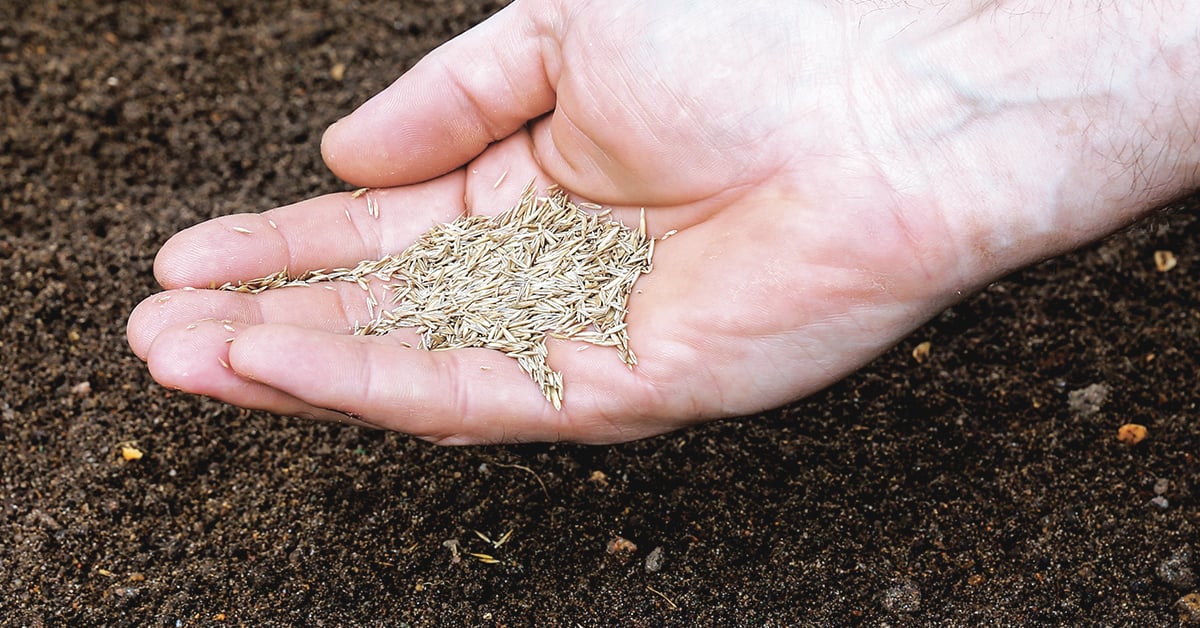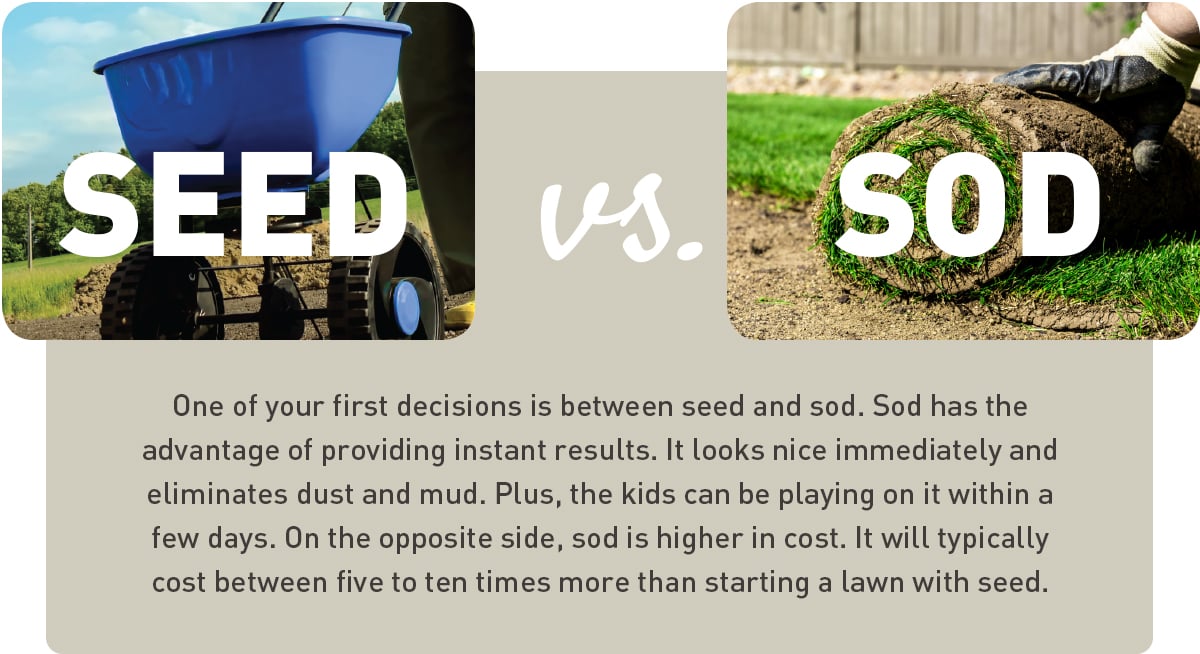
Planting a lawn from seed is a cost-saving alternative to sod. With these steps and a little patience, you will save money and still get a beautiful lawn.
Prepare the Soil for Planting
1. Remove Weeds
When sowing new grass seed, it’s important to remove all weeds, rocks and other debris prior to planting. Attempting to eradicate weeds – especially noxious varieties such as quackgrass, Canada thistle, or field bindweed (morning glory) – will be much more difficult and frustrating once your lawn is established.
TIP: Spray weeds when they've reached 6 inches in height or width with Hi-Yield Killzall Concentrate Weed & Grass Killer (use as directed). After spraying, wait at least 7 days before planting seed. If the weed infestation is severe, you may consider rototilling the soil and waiting two weeks for regrowth. At this point, spray again.
2. Add Soil Amendments
A lush, healthy lawn starts with good soil. Enhance your soil by adding composted organic matter; a material lacking in most native Intermountain West soils. Composted organic matter adds much-needed nutrients, improves compacted clay soils and increases water retention in sandy soils.
TIP: Spread Oakdell Organic Compost or Nutri-Mulch 1-2 inches thick over the entire planting area. Avoid using barnyard manure as it may be contaminated with noxious weed seeds. Once spread, till the composted area 5 to 6 inches deep, preferably with a rear-tine tiller. Use a landscape rake to level and grade the soil gradually away from the house. Water the bare soil for 20 minutes to settle the soil to expose any low spots. Fill in any discovered low spots and re-rake to ensure its level.
3. Stimulate Growth With a Seed Starter Fertilizer
When the area is graded and level, apply a seed starter fertilizer to help stimulate new seedling growth and development.
TIP: Apply IFA Premium Garden Fertilizer or IFA Grand Champion All-Purpose Fertilizer (Follow the “New Lawns, Pre-Plant” directions on the back of the bag.). Both fertilizers are high in phosphate and will encourage rapid root development. Also, consider adding IFA Bountiful Earth Humate to enrich the soil even further and aid seed germination.

Plant Your Grass Seed
Your lawn can be planted any time from early April (or earlier if temperatures permit) through late September. However, the very best time to seed a lawn is between mid-August and mid-September.
While spring is the next best period to plant, excellent results can occur anytime all summer by observing careful watering practices.
1. Sow the Grass Seed
After choosing the right seed for your new lawn, spread it over the soil using either a drop or broadcast spreader. For extra even coverage, spread half of the seed in one direction and the other half in another direction criss-cross to your original path. The seeds may also be sown by using a sweeping hand motion.
2. Roll for Good Seed to Soil Contact
After seeding, fill a lawn roller halfway with water and roll it over the entire seeded area. Roll the perimeter first and finish in the middle. Pressing the seeds into the soil ensures excellent seed to soil contact. It helps increase germination rates and, in general, adds to your chance for successful planting.
3. Top Dress the Planted Seeds
After rolling the seed, apply (approximately) 1/8" layer of Kellogg Topper, peat moss or compost over the seeded area using a compost spreader. A top-dressing covers the seed, holding moisture for proper germination and protecting the seed from birds.
4. Water
Maybe the most important step, it's time to carefully water the planting area. On the first watering, apply enough water to wet the soil down to 6 inches or until it begins to puddle. You don’t want to wash the seed away.
You may need to water several times in short intervals until the bed is thoroughly wet. In the coming days, watch the color of the soil surface. As the soil dries, the surface becomes lighter in color. When you notice about half to two-thirds of the surface is lightening up, it’s about time to water again. Continue to water lightly, and frequently until the seed germinates. Remember, don't overdo it or underdo it. Seeds only have one shot at germination. Let them rot or dry out, and they’re dead.
5. Protect the Seedbed
Try to keep dogs, kids, your own feet, and anything else off your very wet, newly seeded lawn. Try surrounding the area with brightly colored string tied to stakes, or fencing material attached to metal t-posts.
Take Care Of Your Growing Lawn
Depending on the temperature and seed variety, germination can start as early as 5 days but may take as long as 15–30 days. After your grass has germinated, start backing off on the watering frequency and gradually increase the watering amount each time.
As your lawn grows, water ½" to 1" every three days during hot weather. Sandy soils will need more frequent watering, while clay types will require less.
Apply IFA Step 3 Spring & Summer Lawn Food 30 days after most of the seed has germinated. Young seedlings have a hefty appetite. IFA Step 3 will keep the lawn from "stalling" and its slow-release nitrogen will feed its growth for weeks to come.
When the grass has reached a height of 3 to 4 inches, it's time to mow and let the kids run free. After the first mowing, trim your lawn between 1½ to 3 inches (depending on the variety of grass). Avoid applying any weed killers to your new lawn until after the third mowing.
Follow these steps and you'll have a beautiful lawn to enjoy for years to come.
Choose the Right Grass SeedIf you're planning to seed your new lawn, the decision on seed variety is important. A great lawn can only be grown from great grass seeds and IFA selects the best performing cool-season turf varieties for the Intermountain West. IFA GreenStar 5Contains five premium Kentucky Bluegrass varieties. Withstands high stress and wear, and provides a beautiful, dark green lawn. IFA Quick GreenExcellent for sun and partially shaded areas. Germinates quickly and tolerates heavy use. IFA EscalanteA turf-type Tall Fescue blend that's heat and drought-tolerant. Excellent resistance to disease and pests.* IFA Liberty Fescue Bluegrass MixHardy with a longer growing season.* *Liberty and Escalante are both great choices if you live in an especially hot area where irrigation can sometimes be infrequent. |
Lawn Planting Supplies
- Hi-Yield Killzall Concentrate Weed & Grass Killer: Kill weeds prior to seeding lawn.
- Grass Seed: Choose (1) IFA GreenStar5 Bluegrass, (2) IFA Quick Green, (3) IFA Escalante Fescue Blend or (4) IFA Liberty Fescue Bluegrass Mix.
- Starter Fertilizer: Invigorate new seedling growth and establish strong roots. Choose IFA Premium Garden Fertilizer or IFA Grand Champion All-Purpose Fertilizer.
- Oakdell Organic Compost, Nutri-Mulch or IFA Bountiful Earth Humate: Improve the soil, seed germination and root establishment.
- Kellogg Topper, Peat Moss or Compost: Cover the seed evenly 1/8" thick to hold moisture for proper germination, and to protect it from birds.
- Lawn Roller: Increase the seed germination rate with excellent seed to soil contact.
- IFA Step 3 Spring & Summer Lawn Food: Feed new grass seedlings, further establish strong roots, and ensure vigorous new lawn growth. Apply 30 days after complete seed germination.
Let Us Help
Our associates are as passionate about lawn care as you are. Stop by your local IFA Country Store and we'll be happy to answer any questions or help you solve any lawn problem, big or small.
Shop our selection of grass seed mixes chosen specifically for Intermountain West soils
Information for this article was provided by Ken Holt, Lawn & Garden Category Manager, IFA Country Store; and Kent Mickelsen, Utah Certified Nurseryman, IFA Country Store









